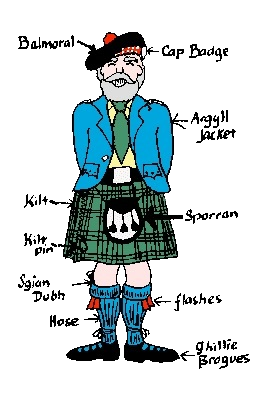Highland Attire
Highland attire is not a costume, it is the national dress of Scotland. Of course, the salient feature is the kilt. This garment was worn by the Highland clans, but it has now been adopted as Scotland's National dress.
The original kilt was merely one piece of wool, worn over a long shirt, or lèine, laid out and pleated in the back and belted around the wearer. Since extra material would then hang down, it was picked up and pinned at the shoulder. In cold or in inclement weather the extra material could be wrapped around the wearer. This garment is called the breacan fèileadh (pron. breck an FAY la), or great kilt.
Today's kilt, known as the small kilt or fèileadh beg (pron. philabeg), has no top part and the pleats, or folds, are sewn into it. The kilt is usually worn for special occasions, such as Highland games or other gatherings of people of Scottish descent. Some wear them at many other times though, such as weddings, funerals, or other occasions for which one would dress.
From the top...
Bonnet:
There are two types of bonnets, or hats, that are worn with the kilt. The gentleman above is wearing a balmoral (pron. bal MOR al). A balmoral is based on what Highlanders used to wear, the traditional blue bonnet. The balmoral is like a beret and has a toorie, or pompom on top. It may be one color or it may have dicing, a checkered band of red, black and white, around it. The ribbon in back should be tied into a bow and the ends trimmed short on the diagonal. In Scotland the balmoral is the preferred bonnet with the kilt.
The other type of bonnet is the glengarry. It has military origins, and folds flat. A glengarry has a toorie, and always has dicing. The ribbons are left long.

Years ago, Highlanders wore a piece of plant in their bonnets to show their clan affiliation. Today, clansmen wear a cap badge. The cap badge, also called the clansman's crest badge, is worn on the left side of the bonnet. In the middle is the crest, or top, of the clan Chief's coat of arms. Around the circle is the Chief's motto, with a buckle and strap.
The cap badge that may be worn by all Campbells includes a crest that is a boar's head, with the Chief's motto, Ne Obliviscaris, on the strap.
Jacket:
What is worn above the kilt changes with the occasion. In the picture above, the man is wearing an Argyll jacket. It is also called a kilt jacket, and is like a sports coat, only shorter. The jacket may have fancy cuffs and pockets, or they may be plain.
For fancy parties there are other coats. One looks like a tuxedo called a tail coat and is called a Prince Charlie Coatee. Another is called a doublet.
If it is warm a short sleeved shirt, or even a t-shirt, can be worn with the kilt.
Belt and Buckle:
A belt and buckle are usually worn with a kilt, but neither are required.
The kilt:
The kilt today is made of many yards of wool. In front are two flat pieces called the aprons. They cross in front of the person, one apron over the other. In back are sewn folds, called pleats. The pleats are folded in two ways. One is called being pleated to the sett. This means that the pleats are folded so that the pattern, or tartan, looks just like it does on the flat part of the kilt, the aprons. The other way is called military pleating. The kilt maker picks a colored stripe in the pattern that runs up and down, and puts that stripe in the center of each pleat.
Kilts, bonnets, and sporrans are men's attire, despite what one may see at gatherings in North America. The exception is when women play in pipe bands.
Women wear kilted skirts, not kilts. The kilted skirts are like kilts, but do not have as much wool, are not pleated the same, and tend to be worn longer.
Sporran:
The sporran (pron. SPOR un) is the man's purse that hangs in front of the kilt. Since a kilt has no pockets, a man in a kilt needs some place to put things such as money or keys. A sporran is made out of leather or fur.
Kilt Pin
The kilt pin: is worn by some men. It is only a decoration and is not required.
Kilt Hose:
Kilt hose are the long stockings that are worn with the kilt. They come to just below the knee, and are folded down at the top.
Flashes:
Flashes are strips of brightly colored wool that hang down from under the fold in the top of the kilt hose. They are attached to pieces of elastic called garters that go around the leg and help to hold up the kilt hose.
Sgian Dubh:
The sgian dubh (pron. skane doo) is the knife that is worn in the top of the kilt hose. Sgian dubh means black or hidden knife in the Gaelic. This is because Highlanders always carried a knife that could not be seen as an extra weapon. Now they are always worn in the top of the kilt hose.
Gillie Brogues:
Gillie Brogues (pron. gilly s) are shoes worn with the kilt. They are open on the top and the laces are wrapped and tied around the leg. One may wear regular shoes instead, however.



 Clan Campbell Society (North America)
Clan Campbell Society (North America)